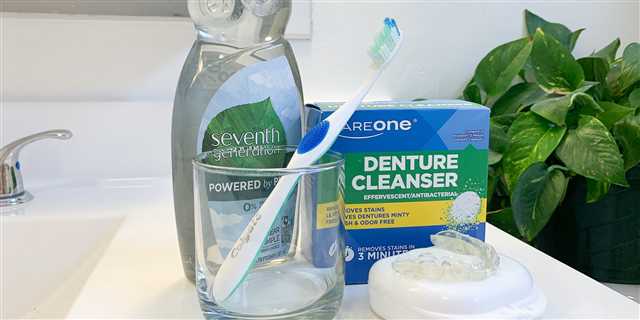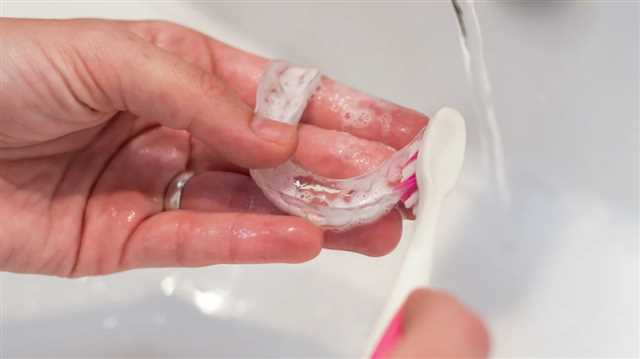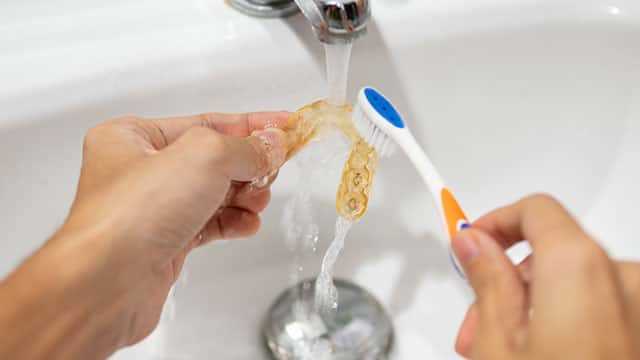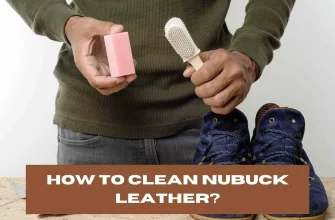
When it comes to proper oral hygiene, cleaning your teeth is an essential step. However, some people may overlook the importance of cleaning their mouth guards, especially ones used during sleep or sports activities. Whether you or your siblings wear mouth guards, it’s crucial to know how to keep them in proper condition.
First and foremost, what you wear in your mouth needs to be clean and replace regularly. After each use, make sure to thoroughly clean and dry your mouthguard before putting it in its designated place. Never share your mouthguard with anyone else, as this can spread bacteria and increase the risk of dental issues.
Note that regular mouthguards used for sports activities may not require as much attention as those used for sleep apnea or teeth grinding. Nevertheless, taking proper care of your mouthguard is important to maintain its function and hygiene.
The first step in cleaning your mouthguard is to rinse it off with warm water. This will help remove any debris or particles that may be stuck to it. After rinsing, you can use a toothbrush and toothpaste to gently brush it, making sure to clean all the nooks and crannies. Be careful not to brush too vigorously, as this can damage the mouthguard.
For a more thorough cleaning, you can soak your mouthguard in an antibacterial dental cleaner. Follow the instructions on the cleaner and let the mouthguard soak for the recommended amount of time. This will help eliminate any germs and bacteria that may be present, ensuring a clean and healthy mouthguard.
After cleaning, make sure to rinse the mouthguard thoroughly to remove any residual cleaner. Once rinsed, place the mouthguard in a clean and dry case to keep it protected and free from contamination. Avoid leaving it in an enclosed space, as this can promote the growth of bacteria.
Lastly, it’s important to note that children’s mouthguards may require different cleaning steps and precautions. Consult with your child’s dental health professional to determine the best way to clean and maintain their mouthguard.
In conclusion, proper cleaning and maintenance of mouth guards are essential for oral health and hygiene. Whether it’s a sports mouthguard or one used for sleep apnea or teeth grinding, always make sure to clean, brush, and soak it regularly. Following these steps will help ensure that your mouthguard is in the best condition and that your oral health remains healthy.
- Caring for Cleaning Mouth Guards
- Step 1: Rinse and Brush
- Step 2: Soak
- Step 3: Air Dry and Store
- Step 4: Replace Regularly
- Step 5: Additional Tips
- A Complete Guide to Proper Maintenance
- Step 1: Rinse after use
- Step 2: Brush with toothpaste
- Step 3: Soak in a denture cleaner
- Step 4: Store properly
- Additional Tips
- When to Replace Your Mouthguard
- 1. Frequency of use
- 2. Age of the mouthguard
- 3. Visible signs of wear and tear
- 4. Pain or discomfort
- 5. Recommendations from a dentist
- 6. Proper maintenance
- Signs that Indicate It’s Time for a New Mouthguard
- Proper Cleaning Techniques
- Steps for Proper Cleaning:
- Effective Methods to Clean and Sanitize Your Mouthguard
- 1. Rinse with Water:
- 2. Clean with a Soft Toothbrush:
- 3. Deep Cleaning:
- 4. Store Properly:
- 5. Replace When Worn Out:
- Storage and Care Tips
- 1. Replace Your Mouthguard Regularly
- 2. Clean Your Mouthguard Weekly
- 3. Store Your Mouthguard Properly
- 4. Avoid Excessive Heat or Cold Temperatures
- 5. Use a Mouthguard during Sports and Other Activities
- 6. Clean Your Mouthguard Immediately after Use
- 7. Protect Your Mouthguard from Biting and Grinding
- 8. Ask Your Dentist for Advice
- 9. Replace Your Child’s Mouthguard as They Grow
- 10. Air Dry Your Mouthguard
- 11. Use a Mouthguard Case When Traveling
- 12. Visit Your Dentist for Regular Check-ups
- Video:
- How to clean mouth guards, retainers, removal braces, dentures etc with the oral appliance care kit
Caring for Cleaning Mouth Guards
Mouthguards are essential for protecting your teeth and oral health. Whether you wear a mouthguard for sports or to prevent teeth grinding (known as bruxism) at night, it’s important to properly care for and maintain your mouthguard to ensure its effectiveness and longevity.
Step 1: Rinse and Brush
After each use, rinse your mouthguard thoroughly with water. Use a soft-bristle toothbrush to gently brush the mouthguard with a non-abrasive toothpaste or a mild soap. It’s very important to avoid using hot water on your mouthguard, as it can warp the plastic and alter the shape.
Step 2: Soak
Weekly, or as recommended by your dental professional, soak your mouthguard in a denture cleaner or a mixture of water and hydrogen peroxide. This will help to remove any bacteria or stains and keep it clean and fresh.
Step 3: Air Dry and Store
After cleaning, let your mouthguard air dry completely before storing it. It’s important to store your mouthguard in a ventilated case to allow air circulation and prevent moisture buildup, which can lead to bacterial growth. Make sure to keep it in a cool and dry place, away from direct sunlight.
Step 4: Replace Regularly
Depending on the condition and usage, mouthguards should be replaced every 3 to 6 months or as recommended by your dental professional. Regularly inspect your mouthguard for any signs of wear and tear, such as cracks or tears, and replace it if necessary. Growing children may need more frequent replacements as their jaws and teeth continue to develop.
Step 5: Additional Tips
- Do not chew on or clench your mouthguard, as it can cause damage and reduce its effectiveness.
- Avoid exposing your mouthguard to extreme temperatures.
- Do not share your mouthguard with others to prevent the spread of bacteria and infections.
- If you have sleep apnea, consult with your dental professional about a custom-fitted mouthguard to help improve your breathing and reduce symptoms.
- If you experience any pain or discomfort while wearing a mouthguard, consult with your dental professional to ensure it fits correctly and is appropriate for your needs.
By following these steps and taking proper care of your mouthguard, you can ensure its longevity and effectiveness in protecting your oral health. Remember, a healthy mouth starts with a clean mouthguard!
A Complete Guide to Proper Maintenance
Proper maintenance of your mouth guard is essential for ensuring its effectiveness and longevity. By following these steps, you can keep your mouth guard clean and free from bacteria and other contaminants.
Step 1: Rinse after use
- After each use, rinse your mouth guard with cold water. This helps remove any saliva, food particles, or other debris that may be present.
Step 2: Brush with toothpaste
- Once a week, brush your mouth guard with a toothbrush and toothpaste. This helps remove any bacteria or odor-causing agents that may have accumulated.
Step 3: Soak in a denture cleaner
- Once a month, soak your mouth guard in a denture cleaner. Follow the instructions on the cleaner for the recommended soaking time.
Step 4: Store properly
- After cleaning, let your mouth guard dry completely. Once dry, store it in a dental case or enclosed plastic container to protect it from dust and germs.
Additional Tips
Here are some additional tips for maintaining your mouth guard:
- Always check with your dentist on the recommended cleaning methods for your specific mouth guard.
- If you experience any pain or discomfort while wearing your mouth guard, immediately stop using it and consult your dentist.
- If you grind your teeth or clench your jaw while you sleep, ask your dentist about getting a custom mouth guard specifically designed for teeth grinding.
- Do not use abrasive cleaners or toothpaste on your mouth guard, as these can wear down the surface and reduce its effectiveness.
- Never wear your mouth guard while eating or drinking, as this can cause damage to both your teeth and the guard itself.
- For sports mouth guards, it’s important to clean them after every use to remove any bacteria or germs that may be present.
- If your child wears a mouth guard for sports, be sure to check it frequently for any signs of wear or damage. Replace it if necessary.
- To protect your teeth from cavities, continue practicing good oral hygiene by brushing and flossing regularly.
By following these maintenance steps and practicing good oral hygiene, you can ensure that your mouth guard remains clean, in good condition, and effective in protecting your teeth.
When to Replace Your Mouthguard
Proper maintenance of your mouthguard is crucial for ensuring its effectiveness and longevity. While regular cleaning can help extend the lifespan of your mouthguard, there will come a time when it needs to be replaced. Here are some important factors to consider:
1. Frequency of use
The more frequently you use your mouthguard, the quicker it will wear out. If you use your mouthguard every day, such as when playing sports or participating in other high-impact activities, it may need to be replaced more often than if you only use it occasionally.
2. Age of the mouthguard
Mouthguards for children may need to be replaced more frequently since their teeth and jaws are still developing. As children grow, their mouths change shape, and their mouthguards may no longer fit properly. Additionally, children may be less careful when handling and cleaning their mouthguards, which can contribute to quicker wear and tear.
3. Visible signs of wear and tear

Inspect your mouthguard regularly for any signs of damage or deterioration. If you notice cracks, holes, or tears in the plastic, it’s time to replace your mouthguard. These damages can compromise its protective function and may increase the risk of injury during impact.
4. Pain or discomfort

If your mouthguard starts causing pain or discomfort while wearing it, it’s a clear sign that it needs to be replaced. Pain or soreness can indicate that the mouthguard no longer fits properly or that it has become worn out and is no longer providing adequate cushioning.
5. Recommendations from a dentist
Always consult with your dentist about when to replace your mouthguard. They can assess the condition of your mouthguard and provide professional advice based on your specific oral health needs. Dentists typically recommend replacing mouthguards every 6 to 12 months, but individual cases may vary.
6. Proper maintenance
Even with regular cleaning, mouthguards will wear out faster if not properly maintained. Always let your mouthguard dry thoroughly before storing it in its case. Avoid placing it in direct sunlight or high temperatures, as this can cause warping or melting of the plastic. Clean your mouthguard weekly with a non-alcoholic mouthwash or mild soap and water to prevent the buildup of bacteria and plaque.
By noting these key factors and staying attentive to the condition of your mouthguard, you can ensure that you are using a clean and effective mouthguard that provides optimal protection for your teeth and overall oral health.
Signs that Indicate It’s Time for a New Mouthguard
When it comes to protecting your teeth, a mouthguard is an essential tool. Mouthguards are commonly used in sports to prevent oral injuries, and they are also used by individuals who grind their teeth at night. However, mouthguards are not meant to last forever. Over time, they can wear out and become less effective. Here are some signs that indicate it’s time to replace your mouthguard:
- Visible wear and tear: Inspect your mouthguard regularly for any signs of damage. If you notice any holes, tears, or cracks, it’s time for a new one.
- Changes in fit: If your mouthguard no longer fits properly, it may not provide the same level of protection. This can happen due to changes in your teeth or jaw alignment, or simply because the mouthguard has stretched out over time.
- Persistent pain or discomfort: If you experience any pain or discomfort while wearing your mouthguard, it could be a sign that it’s no longer fitting correctly or that it’s worn out.
- Dental problems: If you notice any dental issues, such as cavities or gum problems, it could be a sign that your mouthguard is not providing adequate protection. Consult with your dentist to determine if a new mouthguard is necessary.
- Unpleasant odor or taste: Mouthguards can accumulate bacteria and other debris over time, leading to an unpleasant odor or taste. If regular cleaning does not resolve this issue, it may be time for a replacement.
Remember, proper maintenance is key to prolonging the lifespan of your mouthguard. Clean it regularly with a mild soap and warm water, and store it in a clean, dry place. Avoid exposing it to extreme temperatures or harsh chemicals. By taking care of your mouthguard, you can ensure optimal protection for your teeth and oral health.
Proper Cleaning Techniques
- Regular cleaning is essential to maintain the hygiene and longevity of your mouthguard.
- After each use, you will need to clean your mouthguard to remove any bacteria or debris that may have accumulated during wear.
- The best way to clean your mouthguard is to rinse it with water immediately after use.
- For a deeper clean, it is recommended to use an antibacterial mouthwash or a mild soap.
- Some mouthguards can be washed in a dishwasher, so make sure to check the manufacturer’s instructions for proper cleaning methods.
- To prevent the buildup of plaque or bacteria, it is important to thoroughly dry your mouthguard before storing it.
Steps for Proper Cleaning:
- After wearing your mouthguard, remove it from your mouth.
- Rinse it under running water to remove any saliva or loose debris.
- Use a soft toothbrush and toothpaste to gently brush the entire surface of the mouthguard.
- Rinse it again to remove any toothpaste residue.
- Inspect your mouthguard for any visible damage or wear. If you notice any cracks or tears, replace it immediately.
- If your mouthguard is recommended for use with a cleaning solution, prepare the solution according to the instructions.
- Soak the mouthguard in the cleaning solution for the recommended amount of time.
- After soaking, rinse the mouthguard thoroughly with water to remove any residual cleaning solution.
- Pat the mouthguard dry with a clean towel or let it air dry completely before storing.
- Store the mouthguard in its enclosed case to protect it from dust, dirt, and damage.
It is also important to note that mouthguards should be replaced regularly to ensure optimal protection. Over time, mouthguards can become less effective and may lose their shape or integrity. Your dentist can advise you on how often you should replace your mouthguard based on your specific needs.
Effective Methods to Clean and Sanitize Your Mouthguard
Wearing mouthguards is an essential step to protect your teeth during various activities. However, to keep your mouthguard clean and in good condition, it is essential to follow proper cleaning practices. In this guide, we will provide you with effective methods to clean and sanitize your mouthguard.
1. Rinse with Water:
- After each use, rinse your mouthguard with cold water to remove any debris or saliva.
- Do not use hot water, as it can cause the mouthguard to lose its shape.
2. Clean with a Soft Toothbrush:
- At least once a week, use a soft toothbrush to gently scrub your mouthguard.
- Avoid using toothpaste or any abrasive substances, as they can damage the mouthguard’s surface.
3. Deep Cleaning:
- After cleaning, you can use a denture cleaner or a mouthguard cleaner to give your mouthguard a deep clean.
- Follow the instructions provided by the manufacturer for the recommended duration of soaking.
- Make sure to rinse your mouthguard thoroughly with water after soaking.
4. Store Properly:
- Always store your mouthguard in a clean, dry case when not in use.
- Avoid storing your mouthguard in a hot and humid environment, as it can promote bacterial growth.
5. Replace When Worn Out:
- Replace your mouthguard if it becomes worn out, torn, or damaged.
- A worn-out mouthguard may not provide adequate protection and can cause discomfort or pain.
By following these steps, you can ensure that your mouthguard stays clean, sanitized, and in good condition. If you have any additional questions or concerns about cleaning your mouthguard, we recommend consulting your dental professional for the best advice specific to your mouthguard and oral health needs.
Storage and Care Tips
Proper storage and care of your mouthguard are essential for maintaining its effectiveness and prolonging its lifespan. Follow these tips to ensure your mouthguard stays clean and in good condition:
1. Replace Your Mouthguard Regularly

It’s important to replace your mouthguard at least every 6-12 months or as recommended by your dentist. Over time, mouthguards can become worn or damaged, compromising their protective qualities.
2. Clean Your Mouthguard Weekly
Regular cleaning is necessary to remove bacteria and debris from your mouthguard. Soak it in an antibacterial mouthwash or use a denture cleaner to clean the mouthguard thoroughly.
3. Store Your Mouthguard Properly
After cleaning, make sure to store your mouthguard in a clean and dry case. Avoid using plastic bags or other improper storage methods, as they can promote bacterial growth and damage the mouthguard.
4. Avoid Excessive Heat or Cold Temperatures
Keep your mouthguard away from extreme temperatures, as they can cause the mouthguard to deform. Store it in a cool, dry place to prevent any damage.
5. Use a Mouthguard during Sports and Other Activities
Always wear a mouthguard when participating in sports or activities that pose a risk of dental injury, such as contact sports or activities with a high risk of falling or colliding with other players.
6. Clean Your Mouthguard Immediately after Use
After wearing your mouthguard, rinse it with clean water and use a toothbrush to gently clean the surface. Avoid using abrasive cleaners or toothpaste, as they can damage the mouthguard.
7. Protect Your Mouthguard from Biting and Grinding
Avoid biting or grinding on your mouthguard, as it can lead to premature wear and reduce its effectiveness. If you experience teeth grinding or clenching, consult your dentist, who may recommend a different type of mouthguard.
8. Ask Your Dentist for Advice
If you are experiencing any pain or problems with your mouthguard, don’t hesitate to ask your dentist for guidance. They can provide a definitive solution based on your specific oral health needs.
9. Replace Your Child’s Mouthguard as They Grow
If your child wears a mouthguard, make sure to replace it regularly as their mouth grows and changes. Ill-fitting mouthguards can provide less protection and may cause discomfort.
10. Air Dry Your Mouthguard
After cleaning, allow your mouthguard to air dry before storing it. This will help prevent moisture buildup and the growth of bacteria.
11. Use a Mouthguard Case When Traveling
When you’re on the go, it’s best to use a mouthguard case to protect your mouthguard from dirt and damage. Avoid throwing it in your bag or pocket without proper protection.
12. Visit Your Dentist for Regular Check-ups

Regular dental check-ups are essential for maintaining oral health and ensuring that your mouthguard continues to fit properly. Your dentist can also provide recommendations for cleaning and caring for your mouthguard.








